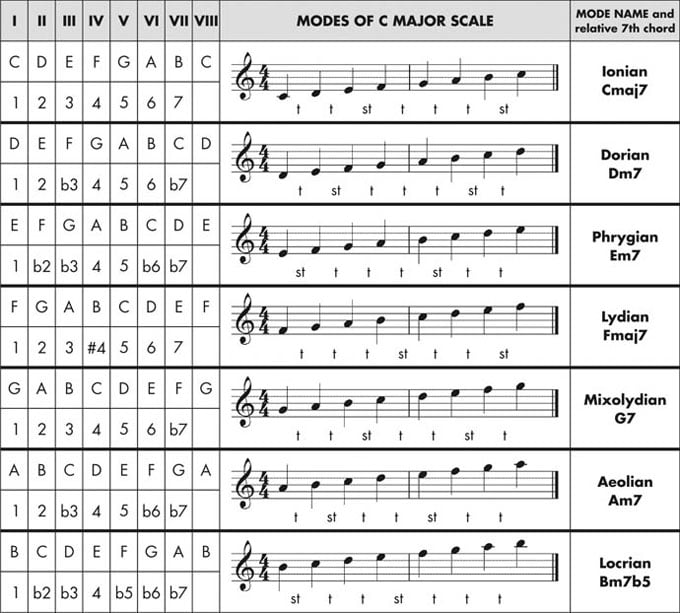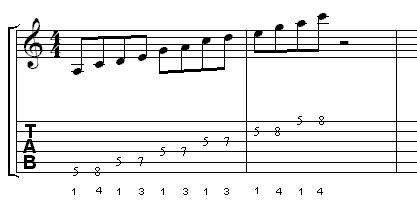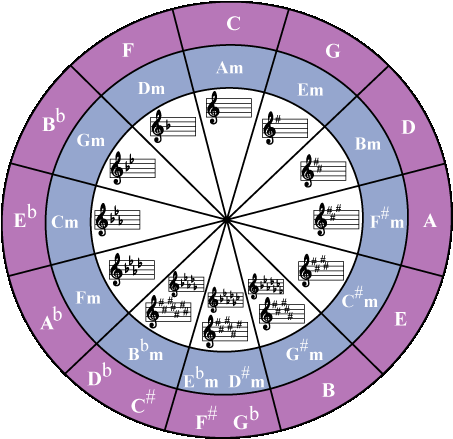"Musika" Composed/Arranged by Bem Orchestrator
From the latin word modus which means "measure, standard, way" it generally and simply refers to a type of scale. It is interesting to note that the beginning note of a modal scale is called the final rather than the tonic as in other diatonic scales.
Modes I, III, V and VII are called authentic because the final is at the bottom of the range. Modes II, IV, VI and VIII are called plagal because they have the same whole and half steps as the authentic but their range sorrounds the final.
Before proceeding any further, for the benefit of those who are totally at a lost regarding modal scales, what are they and how exactly are they constructed. Take a look at the image below.
Look at this image and the given modal scale names. Let me elaborate a little more as to how they are constructed. Let us take into account the C major scale. The Ionian mode is exactly the same with the major scale. So, if you are in the key of C, the Ionian mode is simply C D E F G A B C.
Let us now discuss about the Dorian mode. This scale begins on the 2nd degree of the C major scale going up an octave. Now, its pattern is then like a natural minor scale with a raised sixth degree. The notes are D E F G A B C D.
I hope by now you have figured out how the rest of the modal scales are constructed. For the Phrygian scale on the C major scale, you only begin with the 3rd degree of the C major scale and go up an octave. It is very essential to remember the patterns formed in each scale.

We will be discussing this topic in a more elaborate manner in later chapters, after we have discussed other topics which are pre-requisites of this topic. I hope this little illustration somehow gave you an idea as to how modal scales are made.
Non diatonic Scales
- these are scales that does not observe the interval sequence of a diatonic or a pentatonic scale.
- many of these scales have non identifiable tonic
Chromatic Scale
- this non diatonic scale consist mainly of half-step intervals.
- each tone is equidistant from the next
- the term chromatic also means colored tones, not because it has a visual color but an aural color referring to the certain character of each tone.
Ascending and Descending Chromatic Scale
Note: In a diatonic scale (major or minor) sometimes the use of accidentals employ the use of the chromatic scale, and although all of the 12 tones of a chromatic scale may appear, the tonal characteristic of a scale of the diatonic scale is maintained.
Whole Tone Scale
- this is a 6 tone scale made up of whole steps between adjacent notes
Blues Scale
- this scale is a variant of the major scale with a flat third and a flat 7th degree alternating with the natural 3rd and the natural 7th degree of the major scale.
- this is termed as the blue scale because of its characteristic to inflect a blue feeling (that's how most describe it)
Again the discussion on the topic of blues scale is barely introductory and we will give time to this in future discussions.
Non-Western Scales
- other cultures in the world have many non diatonic scales in their music, it would be really frustrating to discuss them all at once so I am giving just one example.
Octatonic or Diminished Scale
- is an eight-note scale composed of alternating whole and half steps
- jazz musicians call this the diminished scale because the the chords from this scale's pitches are diminished
To be honest, there are tons of non diatonic scales we can find in music and I don't exactly know them all, this post is just to give you guys an idea what separates these scales from our diatonic scale.
The whole objective of this discussion is to give awareness to the student about the existence of non diatonic scales.
Now this is one topic that so many are so confused. I often hear so called musicians talk so much about this and the truth is, they really don't know what they are talking about. I even met a person once who pretended he wants to enroll at our music school but his true purpose was to test our capabilities as teachers. He claimed that he knows ALL of the pentatonic scales and other scales. At the back of my mind I was asking "then why enroll here?" then sometimes I would just love to think of pulling out a chair and slam it hard on his face. Just kidding! He did really get into my nerve.
Well, while he was playing there with his so called pentatonic scales, I asked him a simple question. WHAT MODE ARE YOU PLAYING YOUR PENTATONIC SCALE? He simply said, "I am playing a pentatonic scale." I made another inquiry, "What key are you on right now"? He insisted, "I am playing a pentatonic scale, it doesn't matter."
I couldn't take it any longer and simply said, "Sir, you have no idea what you are talking about just like a blind man giving directions to a stranger."
His words just gave him away, obviously he got himself embarassed and slowly walked out the front door.
Now I am not going to do that to any of you here right now, it was just an isolated case of being where your proper place should be.
For this topic, I will only scratch the surface of the Pentatonic Scales and I will try to make another post later to let us dive deeper into this topic.
What is a Pentatonic Scale?
- as its name suggests, it is a five tone scale. "Penta" means five and "Tonic" means tone.
- this scale is derived from the major scale which has 7 unique pitches.
- there are other pentatonic scales which are unique to a certain culture, but within this topic we will discuss only the pentatonic scale of western music.
How do I construct a Pentatonic Scale?
Major Pentatonic Scales
Let us first remember how we construct our major scales. Our formula for constructing a major scale is WWHWWWH, W means whole and h means half. These series of whole and half steps forms our major scale given any note as our tonic or the first degree of our scale.
Now, to construct a pentatonic scale, we simply use the major scale except for the 4th degree and the 7th degree. We simply omit the 4th and 7th degree of a scale to form our Major Pentatonic.
Listen to how a C Major Pentatonic Scale
There you go! That wasn't so hard after all! By playing the major scale without the 4th and 7th degree, you are actually playing a major pentatonic scale.
The pentatonic scale is also referred to as a gapped scale, one that contains more than a step between adjacent pitches.
We can also do some inversion of the given pentatonic scale above.
These modes above are just inversions of our major pentatonic scale, you play around them or transpose them depending on the need you have.
The following videos are samples of how you can use a pentatonic scale in a melody.
Minor Pentatonic Scale
- the minor pentatonic scale is a 5 note scale but this is one scale that we should be discussing further. For now let me just give you and example and later I will posting a whole new topic focusing specifically on this one.
This is the A minor pentatonic scale
I will discuss this further in a future post. This topic is a complicated one, for the meantime we will just scratch the surface and let us wait for the next post.
So far, we have covered major scales, key signatures and minor scales. Now have you ever ask yourself how one earth could we use such massive informations? Now, now don't panic. We will be discussing it little by little and piece by piece until we see the big picture, MUSIC!
Here we will discuss how major and minor scales relate to each other and how to go round about them. So we can use them with ease as we progress into the seemingly unending world of music.
Relative Relationship
- if a major and a minor scale have the same key signature, then they are said to be in a relative relationship.
We can easily find the relative minor of a given major scale by going to 6th degree of a major scale and start climbing up there until the next 6th degree up or down.
The example above is on key of C Major and the relative minor is A minor since the 6th degree from the tonic is A.
What if you were given the minor scale and you were asked to give its relative major? Simple!
Just go to the third degree of a given minor scale and you will find its relative major scale.
Another way of illustrating the relationship of major and minor scales is through the use of the circle of fifth.
You do not know how to use the circle of fifth? Don't worry, just look at it clockwise and you will find that they are a fifth apart in terms of distance. The purple colored area with capital letters are the Major scales while inside the bluish region of the circle are the relative minor of each Major scale. The inner most circle shows the key signature of each scale.
Looking at it counter clockwise gives you the circle of fourths.
Parallel Relationship
- when a major and a minor scale starts on the same tonic, or their first degrees are both the same then they are said to be in a parallel relationship.
The discussion on the topic of scales is a very enormous one and it would be rather easy to divide scales into topics. That is why I have posted different subdivisions of the topic on scales to let the students or any reader of this blog to understand it better. Now we will dive deeper and deeper into the world of scales, and this time, the minor scales.
The Minor Scale
- this is another type of diatonic scale. One characteristic of a minor scale that distinguishes it from a major scale is the feeling of melancholy or sadness.
- minor scales tend to invoke sad feelings while major scales do the opposite.
The 3 types of Minor Scales
- no need to memorize another set of formulas for this scale, we only need to alter the major scale and that's it.
Natural Minor Scale
- this is composed of 7 unique pitches and each pitch is separated by whole steps except for the second and third degree and the fifth to the sixth degree.
- another approach of constructing this scale is by using the major scale formula but only start at the 6th degree and you will have a natural minor scale!
Listen to the A Natural Minor Scale on the piano
Listen to the A Natural Minor Scale on the guitar
Watch how the A natural minor scale is used in this old christmas tune.
Harmonic Minor Scale
- this scale is different from the natural minor scale because it has a raised 7th degree, or a sharp 7th degree
- this gives the 7th degree a thrust towards the tonic of the scale, thus, making the distance between the 6th and 7th degree a step and a half.
Listen to the A Harmonic Minor Scale on the piano and the guitar
This is an excerpt from Mozart's Sonata in A minor, K 310, III, mm 1-8
The Melodic Minor Scale
- this scale appears in two forms, the ascending form is different from the descending form
- its ascending form has a raised 6th and 7th degree while its descending form is exactly like the natural minor
Listen to how a melodic minor sounds like (nylon guitar)
This is an example of how the melodic minor is used in a melody from Soar Upward to thy God
From Lord Jesus Christ Thou Highest God
This a picture showing the summary of how the 3 types of minor scales look like on A minor. You can transpose it in other keys just to keep you guys thinking.






























